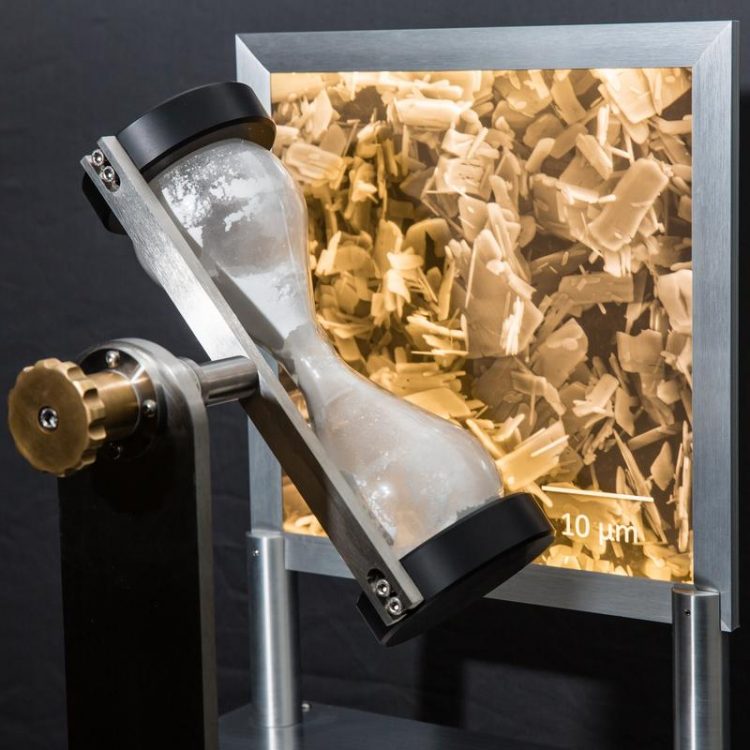Improved corrosion protection with flake-type zinc-phosphate particles

Because of the disordered arrangement of the flakes, they can not run through the sandglass like spheric particles do Source: Ollmann, picture is free
Large quantities of steel are used in architecture, bridge construction and ship-building. Structures of this type are intended to be long-lasting. Furthermore, even in the course of many years, they should not lose any of their qualities regarding strength and safety.
For this reason, the steel plates and girders used must have extensive and durable protection against corrosion. In particular, the steel is attacked by oxygen in the air, water vapor and salts. To prevent the corrosive substances from penetrating into the material, a common method is to create an anti-corrosion coating by applying paint layers of zinc-phosphate particles.
Now, research scientists at INM – Leibniz Institute for New Materials developed a special type of zinc-phosphate particles: They are flake-like in shape because they are ten times as long as they are thick.
The developers will be demonstrating their results and the possibilities they offer at stand B46 in hall 2 at this year's Hannover Messe which takes place from 24th to 28th April.
First experiments with those new, flake-type shaped particles indicate, because of their anisotropy, a better solubility compared to spherical particles. “Now, more phosphate-ions are soluted and repassivation of bare metal surface, for example as a consequence of a mechanical damage, is better and faster,” the head of the program division Nanomers®, Carsten Becker-Willinger says.
“In first test coatings, we were also able to demonstrate that the flake-type particles are deposited in layers on top of each other thus creating a wall-like structure. This means that the penetration of gas molecules through the protective coating is longer because they have to find their way through the ´cracks in the wall´,” the chemist Becker-Willinger explains.
The result was, that the corrosion process was much slower than with coatings with spheroidal particles where the gas molecules can find their way through the protective coating to the metal much more quickly.
In further series of tests, the scientists were able to validate the effectiveness of the new particles. To do so, they immersed steel plates both in electrolyte solutions with spheroidal zinc-phosphate particles and with flake-type zinc-phosphate particles in each case.
After just a few hours, the steel plates in the electrolytes with spheroidal particles were showing signs of corrosion whereas the steel plates in the electrolytes with flake-type particles were still in perfect condition, even after three days.
The flake-type shaped zinc-phosphate particles are synthesized in a controlled precipitation process developed at INM.
Your expert at INM
Dr.-Ing. Carsten Becker-Willinger
INM – Leibniz Institute for New Materials
Head Nanomers®
Phone: +49681-9300-196
nanomere@leibniz-inm.de
INM – Leibniz Institute for New Materials, situated in Saarbrücken, is an internationally leading centre for materials research. INM conducts research and development to create new materials – for today, tomorrow and beyond. Research at INM is performed in three fields: Nanocomposite Technology, Interface Materials, and Bio Interfaces. INM is an institute of the Leibniz Association and has about 240 employees.
Media Contact
All latest news from the category: Materials Sciences
Materials management deals with the research, development, manufacturing and processing of raw and industrial materials. Key aspects here are biological and medical issues, which play an increasingly important role in this field.
innovations-report offers in-depth articles related to the development and application of materials and the structure and properties of new materials.
Newest articles

An Endless Loop: How Some Bacteria Evolve Along With the Seasons
The longest natural metagenome time series ever collected, with microbes, reveals a startling evolutionary pattern on repeat. A Microbial “Groundhog Year” in Lake Mendota Like Bill Murray in the movie…

Witness Groundbreaking Research on Achilles Tendon Recovery
Achilles tendon injuries are common but challenging to monitor during recovery due to the limitations of current imaging techniques. Researchers, led by Associate Professor Zeng Nan from the International Graduate…

Why Prevention Is Better Than Cure—A Novel Approach to Infectious Disease Outbreaks
Researchers have come up with a new way to identify more infectious variants of viruses or bacteria that start spreading in humans – including those causing flu, COVID, whooping cough…



